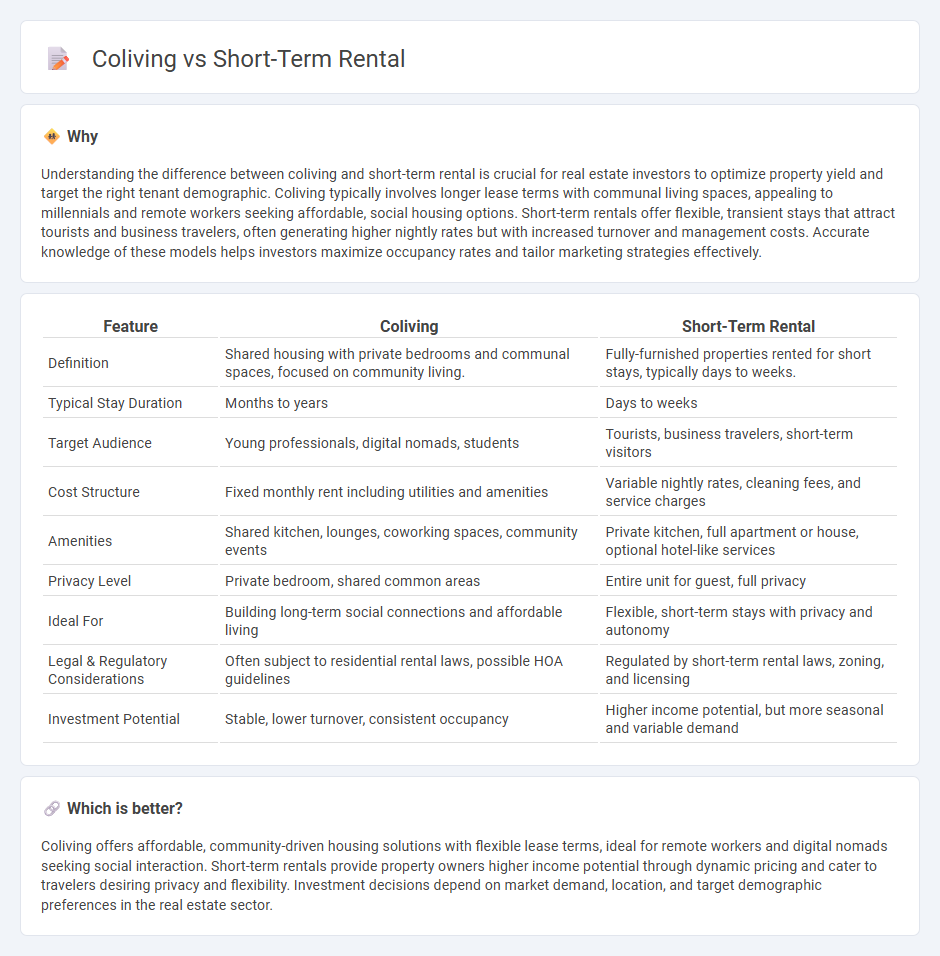
Coliving offers residents shared living spaces designed to foster community and reduce housing costs, appealing to young professionals and digital nomads seeking flexibility and social interaction. Short-term rentals provide fully furnished, private accommodations for travelers and temporary residents, catering to those valuing privacy and convenience in locations like urban centers and vacation hotspots. Explore detailed comparisons to understand which housing model aligns best with your lifestyle needs and investment goals.
Why it is important
Understanding the difference between coliving and short-term rental is crucial for real estate investors to optimize property yield and target the right tenant demographic. Coliving typically involves longer lease terms with communal living spaces, appealing to millennials and remote workers seeking affordable, social housing options. Short-term rentals offer flexible, transient stays that attract tourists and business travelers, often generating higher nightly rates but with increased turnover and management costs. Accurate knowledge of these models helps investors maximize occupancy rates and tailor marketing strategies effectively.
Comparison Table
| Feature | Coliving | Short-Term Rental |
|---|---|---|
| Definition | Shared housing with private bedrooms and communal spaces, focused on community living. | Fully-furnished properties rented for short stays, typically days to weeks. |
| Typical Stay Duration | Months to years | Days to weeks |
| Target Audience | Young professionals, digital nomads, students | Tourists, business travelers, short-term visitors |
| Cost Structure | Fixed monthly rent including utilities and amenities | Variable nightly rates, cleaning fees, and service charges |
| Amenities | Shared kitchen, lounges, coworking spaces, community events | Private kitchen, full apartment or house, optional hotel-like services |
| Privacy Level | Private bedroom, shared common areas | Entire unit for guest, full privacy |
| Ideal For | Building long-term social connections and affordable living | Flexible, short-term stays with privacy and autonomy |
| Legal & Regulatory Considerations | Often subject to residential rental laws, possible HOA guidelines | Regulated by short-term rental laws, zoning, and licensing |
| Investment Potential | Stable, lower turnover, consistent occupancy | Higher income potential, but more seasonal and variable demand |
Which is better?
Coliving offers affordable, community-driven housing solutions with flexible lease terms, ideal for remote workers and digital nomads seeking social interaction. Short-term rentals provide property owners higher income potential through dynamic pricing and cater to travelers desiring privacy and flexibility. Investment decisions depend on market demand, location, and target demographic preferences in the real estate sector.
Connection
Coliving and short-term rentals both cater to urban dwellers seeking flexible, community-oriented living solutions that maximize space efficiency and affordability. Real estate developers leverage short-term rental platforms to attract a transient demographic that values social interaction, shared amenities, and convenience in prime city locations. Integrating coliving models with short-term rental strategies enhances occupancy rates and diversifies revenue streams within competitive real estate markets.
Key Terms
Lease Agreement
Short-term rental lease agreements typically span days to weeks, offering flexibility with minimal commitment, often including furnished spaces and utilities in one bundled payment. Coliving agreements usually require longer commitments, such as monthly leases, emphasizing community living with shared amenities and spaces, and clearer terms regarding house rules and shared responsibilities. Discover more about how lease structures impact your living experience and financial planning.
Occupancy Rate
Short-term rental properties typically experience higher occupancy rates during peak travel seasons due to their appeal to tourists seeking flexible stays. Coliving arrangements maintain more stable occupancy year-round by catering to remote workers and long-term residents valuing community and affordability. Explore detailed occupancy trends and financial comparisons to optimize your investment strategy.
Shared Amenities
Shared amenities in short-term rentals typically include basic features like kitchens and laundry facilities that cater to temporary stays, promoting convenience and privacy. Coliving spaces emphasize communal areas such as coworking zones, lounges, and group kitchens designed to foster social interaction and community building among residents. Explore more about how these shared amenities impact your living experience and community engagement.
Source and External Links
What is Considered a Short-Term Rental? - GovOS - This webpage defines short-term rentals as rentals of residential units for short periods, often categorized into entire homes, accessory dwellings, or individual rooms.
Short-Term Rental | City of Chandler - This page provides information on short-term rental licenses in Chandler, including requirements and regulations for operating a short-term rental business.
Short Term Rentals - City of Spokane, Washington - This webpage explains the process for obtaining a permit for short-term rentals in Spokane, which includes rentals of residential units for less than 30 nights.
 dowidth.com
dowidth.com